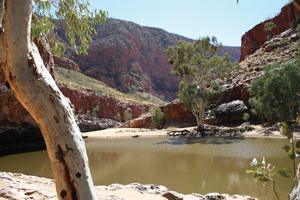It remains unclear how federal government intervention measures in Indigenous communities in Central Australia will create sustainable, safe and nurturing communities
In 2006, revelations offered by the Alice Springs Crown Prosecutor outlining an accumulated dossier of abhorrent cases of child sexual abuse in Central Australia were met with immense public horror.1 The response was understandable, but failed to acknowledge that the dossier echoed the voices of Aboriginal communities’ repeated calls for action over the span of several decades — voices that had been ignored.
The response, from public commentary and an increasingly vocal anti-Aboriginal-rights sector, was swift and damning, editorialising the suffering of Aboriginal communities. In many respects, a new (or rekindled) language emerged, the language of “Aboriginal deficit”. The media were awash with claims of “paedophile rings”, of a culture that “accepted and protected” the raping of children, of “customary law being used as a shield to protect abusers”.2,3 The inference was that all Aboriginal men are “perpetrators”, all Aboriginal children are abused, and that these abuses — fuelled by alcohol, petrol and kava — are compounded by social dysfunction that is largely the consequence of a “primitive” and “barbaric” culture.

Public commentary allowed the seeds of change to be sown, change that “required” a “new paternalism”, “normalisation” or “mainstreaming”; that called for the closure of “unviable remote communities”; that touted the “failure of self-determination”; that required an end to “political correctness gone mad” and the “pouring billions of dollars down the toilet”.4,5 Unfortunately, such language has been used to justify blatantly discriminatory policy.
In response to public reports, the Northern Territory Government initiated an investigation into the issues of child sexual abuse. These issues were recorded, collated and considered within the Ampe akelyernemane meke mekarle: “little children are sacred” report.6
The “Little children are sacred” report, irrespective of its integrity and worthiness, joins a disturbingly long list of reports whose recommendations have been largely ignored. In comparison, however, it may well stand out as one of the most blatantly bastardised of all Aboriginal health reports, in that the federal government has “delivered” the NT intervention, in rhetoric, as a means of protecting Aboriginal children. Yet, despite claims that the report guided and was the impetus for the federal government’s intervention, surprisingly few of the report’s recommendations have been considered or implemented. In fact, many commentators have suggested that the report has been used as a shield to force the imposition of an existing federal government agenda to dismantle any semblance of collective and individual rights, native title, and self-determination among Australia’s first people.7
The most fundamental of all questions remains: will the intervention actually make children safer?
In the weeks and months following the announcement of the NT intervention, it has become clear that decisions were made in a policy and strategy vacuum. Activities have been poorly coordinated, poorly planned, and liable to change and backtracking. This has fuelled confusion and paranoia, and created enormous concern about the squandering of desperately needed resources, which are being used largely to install the bureaucracy rather than provide services.8
A nation and its people are judged on how they treat their most vulnerable, disadvantaged and marginalised. The significance of our current federal government’s refusal to ratify the United Nations Declaration on the rights of indigenous peoples9 has not been lost on Aboriginal people and their advocates.10,11 On the one hand, the government purports to be taking action to protect vulnerable Aboriginal children, yet on the other, it fails to support any national or international requirement or responsibility to recognise and acknowledge native title, cultural integrity, self-determination, and preservation of Indigenous knowledge and sovereignty, as set out in the UN Declaration.9 It is our responsibility, then, as individuals, professionals and as a nation, to ask how our government’s stance on these issues can coexist with the stated aim of protecting our most vulnerable, our children, our future.
- 1. Australian Broadcasting Corporation. Crown Prosecutor speaks out about abuse in Central Australia [television program transcript]. Lateline 2006; 15 May. http://www.abc.net.au/lateline/content/2006/s1639127.htm (accessed Nov 2007).
- 2. ABC News. Break up Indigenous paedophile rings: Brough. 2006; 17 May. http://www.abc.net.au/news/stories/2006/05/17/1640175.htm (accessed Nov 2007).
- 3. Kearney S, Wilson A. Raping children part of “men’s business”. The Australian [Internet] 2007; 4 Nov. http://www.theaustralian.news.com.au/story/0,20867,19149874-2702,00.html (accessed Nov 2007).
- 4. Johns G. Social stability and structural adjustment. Bennelong Society Sixth Annual Conference: Leaving Remote Communities; 2006 Sep 2; Melbourne. http://www.bennelong.com.au/conferences/pdf/Johns2006.pdf (accessed Nov 2007).
- 5. Brough M. Blueprint for action in Indigenous affairs [speech]. National Institute of Governance, Indigenous Affairs Governance Series; 2006 Dec 5; Canberra. http://www.facsia.gov.au/internet/Minister3.nsf/content/051206.htm (accessed Nov 2007).
- 6. Wild R, Anderson P. Ampe akelyernemane meke mekarle: “little children are sacred”. Report of the Northern Territory Board of Inquiry into the Protection of Aboriginal Children from Sexual Abuse. Darwin: NT Government, 2007. http://www.nt.gov.au/dcm/inquirysaac/pdf/bipacsa_final_report.pdf (accessed Nov 2007).
- 7. Aboriginal alliance says government plan “unworkable”. National Indigenous Times [Internet] 2007; 28 Jun. http://www.nit.com.au/news/story.aspx?id=11795 (accessed Nov 2007).
- 8. Four months later and key elements of intervention haven't been implemented: study. National Indigenous Times [Internet] 2007; 8 Nov. http://www.nit.com.au/news/story.aspx?id=13257 (accessed Nov 2007).
- 9. Office of the United Nations High Commissioner for Human Rights. Declaration on the Rights of Indigenous Peoples. http://www.ohchr.org/english/issues/indigenous/declaration.htm (accessed Nov 2007).
- 10. McQuire A. Passing of UN Declaration after two decades a “milestone”: Calma. National Indigenous Times [Internet] 2007; 14 Sep. http://www.nit.com.au/News/story.aspx?id=12694 (accessed Nov 2007).
- 11. Szoke H. Indigenous rights need to be included in Victorian charter. The Age (Melbourne) [Internet] 2007; 26 Sep. http://www.theage.com.au/text/articles/2007/09/25/1190486307024.html (accessed Nov 2007).





None identified.